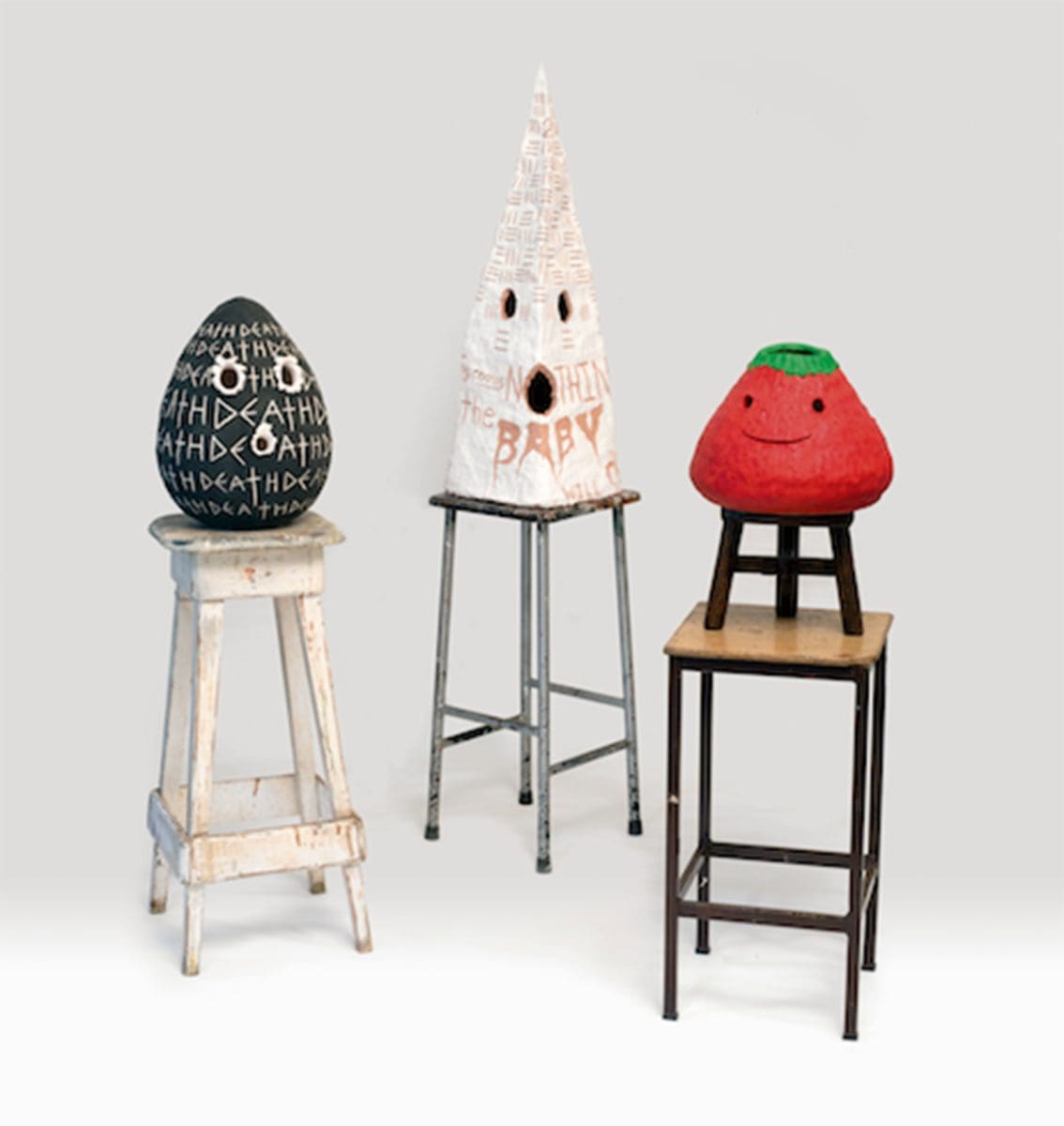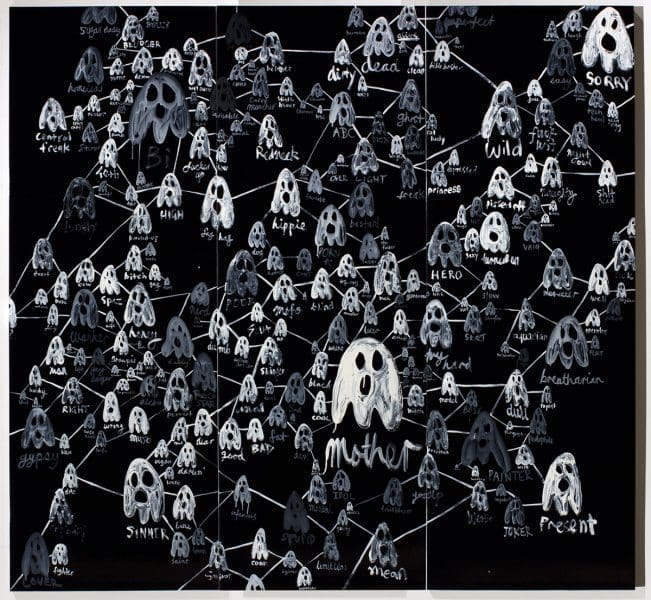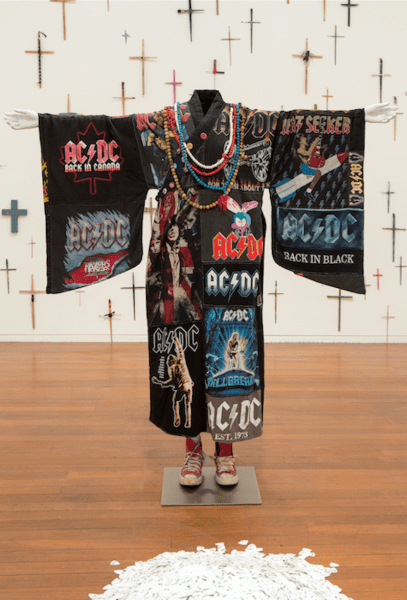
Finding New Spaces Together
‘Vádye Eshgh (The Valley of Love)’ is a collaboration between Second Generation Collective and Abdul-Rahman Abdullah weaving through themes of beauty, diversity and the rebuilding of identity.




The artist known only as Nell uses wisdom gained from both Buddhism and rock ‘n’ roll to create cheeky artworks that delve into deep issues. Tracey Clement chatted to Nell about AC/DC, spirituality and death while the artist was installing her major survey show at the Shepparton Art Museum (SAM).
Tracey Clement: When I think about AC/DC, Buddhism isn’t the first thing that comes to mind! Tell me how they connect in your practice?
Nell: Well they connect because they are part of my life and nothing is really that far away from anything else. And I find in my own experience, that there are more similarities than you would expect.
There is a still from my Quiet/Loud video that they are using to promote the exhibition that shows me meditating on top of an amplifier while a chick is rocking-out on a guitar. And when you think about it, when you are sitting still your mind is usually racing and you are thinking about all these things, but when you are wholly engaged in an activity with your body and mind, like playing the guitar, chances are your mind is not wandering. So there is an irony there. I’m the one sitting still, but I could be thinking about my dirty laundry. She is the one who is wholly engaged, and wholly embodied.
The other side of it is that feeling of being connected to others through music. And not feeling that the boundaries of your body stop with you, which is a very Buddhist concept. We all breathe the same air and that membrane between us is what drops away during meditation. But when you are in a rock concert with lots of people, it’s very primal and tribal, and you have the same feeling.
TC: That’s right. Being in one of those massive concerts can elicit an ecstatic, almost spiritual, experience. Was rock ‘n’ roll your first experience of spirituality?
Nell: My first experience was probably going to church. But you know, when I went to church, I found it really similar to going to rock concerts.
And the aesthetic experiences are very similar, believe it or not.
So the first aesthetic I ever really knew was church and the second aesthetic I knew was seeing boys walk down the street and Maitland [NSW] wearing AC/DC T-shirts and ripped black jeans: it was a whole look.
And I think I am still making work about the collision of those two things!
TC: AC/DC seem to hold special significance for you…
Nell: Growing up with them they were just part of my DNA, like Cold Chisel are for lots of Australians… It’s that tribal thing. When you go to those concerts there are like 50,000 people, all that energy. I guess it’s like sporting matches too: it doesn’t matter what you do in your day job, you are all there.
I also like that AC/DC is colloquial for bisexual: flipping between these two things. It’s like black-and-white, and that dovetails with other themes in my work.
And it’s one of those things that you dismiss as low culture, but actually it is our culture. It’s who we are. It’s like that Countdown clip that I re-staged, AC/DC’s 1976 performance of It’s a Long Way to the Top if you Wanna Rock ’n’ Roll: that is bona fide Australian culture!

TC: Much of your work in the SAM show is obviously hand crafted, like your Let There be Robe kimono made from AC/DC T-shirts and the 41 ceramic figures that make up The Wake. Do you do all the work yourself? And what is the role of labour in your work?
Nell: Yes, I hand sewed that robe, and I made all 500 crosses that go with it. I also made all the figures that are in The Wake. I love having a practice were I make things in my own studio with my own hands, but I do also work on big projects that require more than me: manufacturing, or engineers. So I like having both.
The role of labour is that it is a practice that is the same as meditation. You just sit down, and you do not get up. And you watch your mind, you watch your mind skirt off from what you’re doing and you bring it back. You have an intention for what you are doing, but you have to look at what is actually happening in front of you, and it changes. And you have to decide, do you stay with the intention, or maybe the material is telling you to go somewhere else… It’s the practice of being present in the hand-making and the materiality.
TC: Much of your work seems to deal with death using dry humour and wit. I remember seeing your Happy Ending, gravestone-smiley face, and it really stayed with me…
Nell: I guess through my Buddhist training I try hard to reintegrate death back into life. It’s such a big part of life and we’re not that good at talking about it in Western culture. In fact we are absolutely shithouse, right? And something like that is really funny and really serious at once… You don’t have to have any academic or art history knowledge to get it.
Dying isn’t funny, I don’t want people to think that I think it’s funny, but it is part of life. And we don’t talk about it enough.
TC: And humour offers a way in…
Nell: Exactly, here we are talking about it because of that work.
TC: In addition to the Let There be Robe installation and The Wake figures, what else will we see in your SAM survey show? Are you making new work?
Nell: There are six rooms of work! There are also album grids: grids of AC/DC’s Back in Black album and the White Album by the Beatles in a face-off together. And the new work is this sort of cabinet of curiosities that has some of my work in it and I’m mixing it up with works from the SAM collection.
It’s a combination of all the things I’m interested in. So there are works with faces; there are Asian works, because I’m interested in Asian philosophy; there is Australiana, because I’m Australian; I picked things that are black-and-white, because they are colours I like; there are works that relate to cross-cultural spirituality, and lots of indigenous ceramics, some of my friend’s works, and old Japanese ceramics. It’s a real mash-up of everything I love!
Nell
Shepparton Art Museum (SAM)
8 October – 27 November
From the archives – we revisit our studio visit with Nell from our September/October 2013 print issue here.